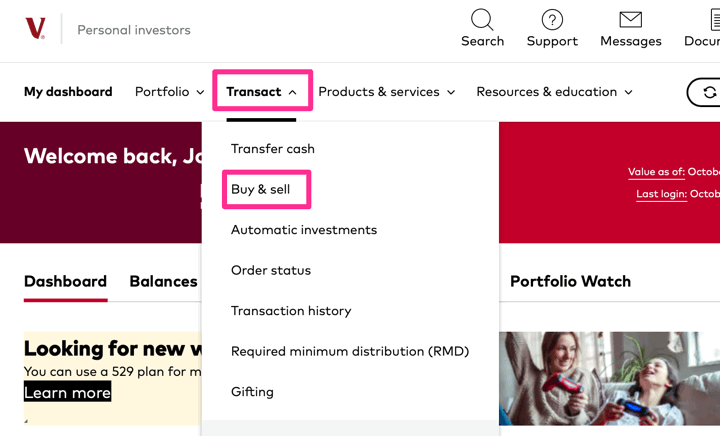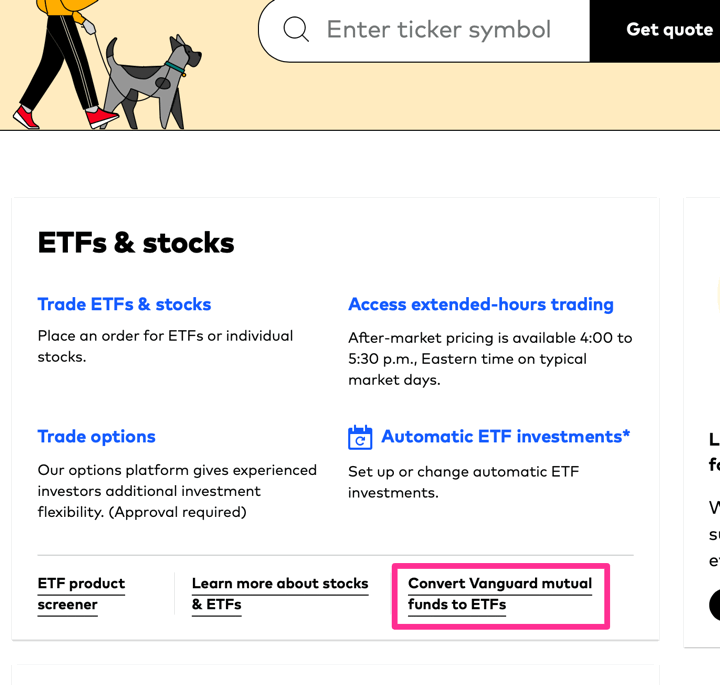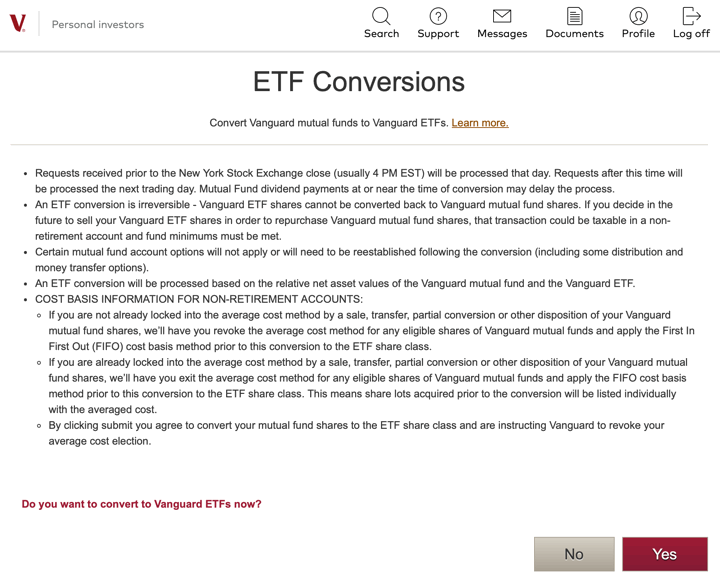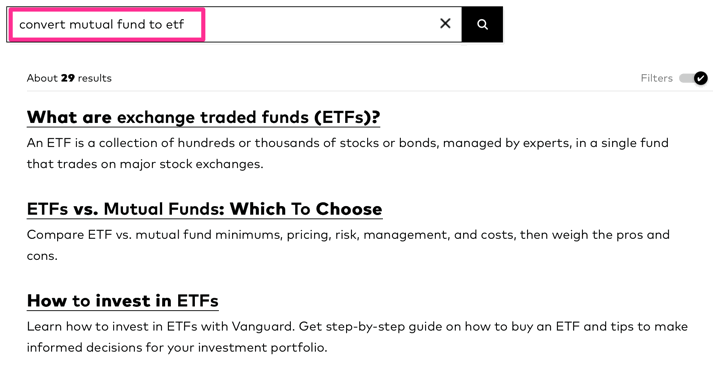Earlier this year, I discussed why I decided to convert my Vanguard mutual fund to ETFs. I don’t regret the decision, and some of those portable Vanguard ETFs later went to Robinhood for a $8,000 payday ? (that offer is back again this week…). At the time, the only way to convert was to call into Vanguard and listen to a lot of disclosures over the phone. As of late 2024, you can again convert Vanguard mutual funds to their ETF equivalent directly on the Vanguard.com brokerage website.
However, the feature is somewhat hidden, as a search for “convert mutual funds to ETF” does not come up with a useful answer, even those it comes up as a predicted search request:
Hopefully this quick how-to will spare you some wasted time. After you log in to your Vanguard account, look for the “Transact” menu option on the top search bar. See screenshot. After that, click on “Buy & Sell”. (It won’t show up as an option under the “Transact” option in other parts of the site.)

After that, you have to look for a smaller text link that says “Convert Vanguard mutual funds to ETFs”.

This should bring you finally to the main conversion page:

There are some disclosures; I have copied them below for reference. After that, you will locate the mutual funds you want to convert. The conversion should happen either same-day or next-day. Afterward, I would double-check to make sure your cost basis is carried over properly.
– Requests received prior to the New York Stock Exchange close (usually 4 PM EST) will be processed that day. Requests after this time will be processed the next trading day. Mutual Fund dividend payments at or near the time of conversion may delay the process.
– An ETF conversion is irreversible – Vanguard ETF shares cannot be converted back to Vanguard mutual fund shares. If you decide in the future to sell your Vanguard ETF shares in order to repurchase Vanguard mutual fund shares, that transaction could be taxable in a non-retirement account and fund minimums must be met.
Certain mutual fund account options will not apply or will need to be reestablished following the conversion (including some distribution and money transfer options).– An ETF conversion will be processed based on the relative net asset values of the Vanguard mutual fund and the Vanguard ETF.
COST BASIS INFORMATION FOR NON-RETIREMENT ACCOUNTS:
– If you are not already locked into the average cost method by a sale, transfer, partial conversion or other disposition of your Vanguard mutual fund shares, we’ll have you revoke the average cost method for any eligible shares of Vanguard mutual funds and apply the First In First Out (FIFO) cost basis method prior to this conversion to the ETF share class.– If you are already locked into the average cost method by a sale, transfer, partial conversion or other disposition of your Vanguard mutual fund shares, we’ll have you exit the average cost method for any eligible shares of Vanguard mutual funds and apply the FIFO cost basis method prior to this conversion to the ETF share class. This means share lots acquired prior to the conversion will be listed individually with the averaged cost.
– By clicking submit you agree to convert your mutual fund shares to the ETF share class and are instructing Vanguard to revoke your average cost election.
Here’s what is inside the “Learn More” link:
– Vanguard Brokerage is required to send you an ETF prospectus for each mutual fund converted to an ETF. The prospectuses will be sent according to your mailing preferences.
– There is no fee for Vanguard Brokerage clients to convert Vanguard mutual fund shares to Vanguard ETFs of the same holding.
– Vanguard will apply the IRS default method of FIFO to ETF holdings. With this method, the shares you bought first will automatically be the first shares relieved.
– If you are already invested in the ETF share class for the fund to which you are converting your mutual fund shares, and you have elected a cost basis method other than FIFO the shares you receive as result of this conversion will follow that election.
– If you are not already invested in the ETF share class for the fund to which you are converting, Vanguard will apply the default method of FIFO for new ETF shares you receive as a result of this conversion. You can select a different cost basis method after the conversion.*Noncovered shares: The average cost method will carry over to the ETF for the non-covered shares, but you are free to report the shares using another method on your tax form. The cost basis of noncovered shares is sent to you for informational purposes only and will not be reported to the IRS by Vanguard. You are responsible for reporting the sale of noncovered shares.




